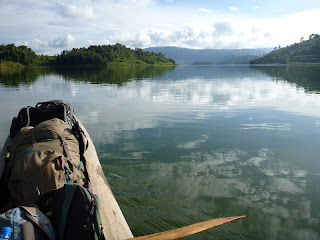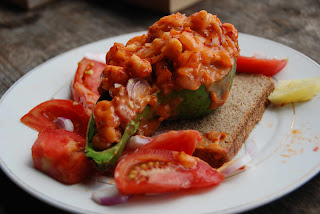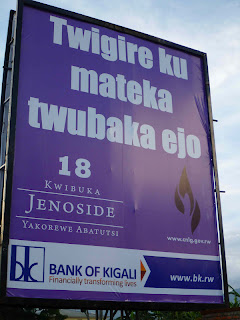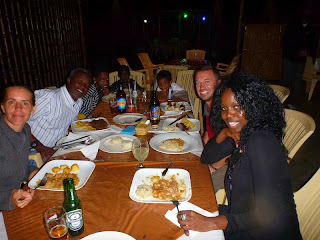To See Our Rwanda Photos, Click HEre
 |
Native Dance Show in the Morning of our Walk
|
We arrived in Africa with certain activities that we wanted to do. Safaris of course, Victoria Falls, Kilimanjaro to name a few, but one that always stuck in our mind was visiting the endangered mountain gorillas that roam the parks on the border of Uganda, Rwanda and Democratic Republic of Congo. The parks are all joined and of course, the gorillas don't need a passport to cross from one to another. The gorilla tracking stood in our mind for another reason…… the cost. We had known for months that the price of one single hour (and of course the time to hike to find them) with the gorillas was $500 per person. It always was a worry - would we actually FIND them, and not waste the $500?? And find them we did indeed - making it sooooooo worth it.
The Parc Nationale des Volcans is a small park in the North West of Rwanda. We chose to track in Rwanda as we heard that it is more organized, therefore giving us a better chance of finding them. And the park area was beautiful, surrounding the small town of Musanze (formerly Ruhengeri) with a string of pointy volcanoes, all visible from town. Taking out the difficulty of finding accommodation, we met two girls on the bus who were headed up to Musanze for a day with the kids at the St. Vincent
 |
The St. Vincent Orphans
|
orphanage. They said that there was accommodation there, cheapest in town, and of course the money would go to supporting the orphans - always a good cause.
I was not ready for the greeting we got though. It was an orphanage for disabled children, and some were in a very bad way, quite sad. But the smiles and hugs we got on arrival was unlike any greeting we had had in a long time!! They were just soooo happy to see us! We spent a little time with the kids, and I even got a special, secret handshake with one of the little boys, who had braces on his legs and a huge smile!
We were both excitedly nervous on the evening before the hike - we didn't really sleep too well. We had arranged the 4x4 transport to the park with some others, and were all unloaded at the park entrance where we met a large crowd. It was quite the variety of people there planning on finding the
 |
Our First Close Up Encounter
|
gorillas. Some fresh in new safari gear, other teenagers in jeans and light sneakers looking totally unprepared to hike in the dense jungle, and some like ourselves, hardened travellers in worn out clothes!! Whatever the means, they were all there for one reason, to be another of the approximately 19,000 people that try to spot the gorillas yearly in Rwanda. We were greeted by local dancers, who put on a quick, early morning show in front of the volcanoes!
They sort you into groups of maximum 8, and with these 8 you will be guided to one single family of gorillas, whether they are 26 strong, or only a small family. Not sure how they decide this, but we were off to see the Umubano family, with Charles the Silverback and leader of the family. We were surprised to hear that there was now

20 families, whereas in our guide book of five years ago, they only had about 10 families. The increase is from gorilla families making the trek from Uganda, and also, some of the families have actually split as a new Silverback comes of age and takes some females with him. We were also very happy to hear that in 1981, there were around 250 mountain gorillas in total, and now, there are about 800. So the dollars are working to keep this amazing species alive - at least some consolation that the money is going to the right place!
A bumpy ride to the trailhead, and a walk through local fields with our guides Fidel and Bernice, we finally crossed the buffalo wall into the park. We then met our guard complete with rifle to protect us, and Joseph who was our machete man for cutting through the jungle. We playfully took to calling
 |
The Thinker??
|
 |
Charles, the Silverback
|
him Joseph and his Amazing Teknicolor Machete!! The jungle was dense, with plenty of vines grabbing you, and loads of painful stinging nettles. At some time we were also in thick bamboo growths. And after an hour and a half of slogging, we met up with two trackers, who stay with the gorillas for days on end. That means we were very close, and the adrenaline started really flowing. They were only about 100m away, and we WERE going to see them….WOW!
Our first glimpses were of a couple of them balanced on branches in the trees, about 30m away. But, out of the blue, one suddenly crossed our path, not 2m away, and then sat beside us, chewing away on some foliage. Not raising an ounce of concern that we were there. Then we found Charles…. 200kg of silverback gorilla in his home territory. His face had wonderful features and expressions with a
 |
This is how CLOSE we were!!!
|
tuft of brownish-red hair on his forehead, and once again, not a shred of concern about us. In fact, he walked past us in touching distance, showing of the silver hairs on his back. I really can't explain the feelings of seeing such a majestic creature at such close range, and in the wild. The hairs rise on your back, and your stomach get's butterflies. It's truly tremendous, and the feelings almost repeat while I write this!!
Then, if I can say it, but the real stars of the show - the young and babies. The mothers didn't mind us there, and the young ones were just playing about on the vines, almost putting on a show for us. Often flipping upside-down, and sometimes falling from the vines into the foliage. They were having fun, just like human kids would. And the curious, possibly smiling faces that we were so close to… Orangy-red striking eyes, with black nostrils flaring with each breath. It was surreal. We were supposed to stay about 7m from the gorillas, but the guides took us close, and the gorillas came closer at times. One of the females actually beat her chest a few times. Michelle thought this would only be done by males, and that this
 |
The Youngest Baby
|
must be a sign of aggression or warning, but the guides told us that it is a sign she is happy. Pretty cool though, as this was the prototypical action we think of with gorillas.
Unfortunately, before we knew it, our 1 hour was up. They are very strict about this, and I guess for good reason. They don't want the gorillas to get too comfortable and so used to being around humans. They need to stay wild. We thanked our trackers, and hope they continue doing the good job they do, of keeping the poachers at bay. Since Dian Fossey first started her research and protection of the gorillas, the numbers have increased because of the protection from poachers. Unfortunately, Dian Fossey paid the ultimate price for her cause, and was apparently killed by poachers at her
research station in the park, poachers who didn't like her getting in the way. Her legacy lives on

though, and her story is portrayed in the movie 'Gorillas in the Mist'.
We returned from our trek, parting ways with our guides, guard, teknicolor machete men, and some friends we had made on our special adventure. Tamar, Gilles, Kate and Sarah were all on Cloud Nine too after the experience.
We met up with Tamar and Gilles later for dinner at our favourite little cafe in town, Les Paillotte, which served up some delicious pizzas for only 1500 Rwanda Francs ($2.50). Far less than the rest of the day cost, and even better for us that we arrived in Rwanda when we did, as they are raising the cost to visit the gorillas in June to a staggering $750 per person - OUCH!! I guess they can, because people keep coming and paying the fees - we did!! *Stub



























































